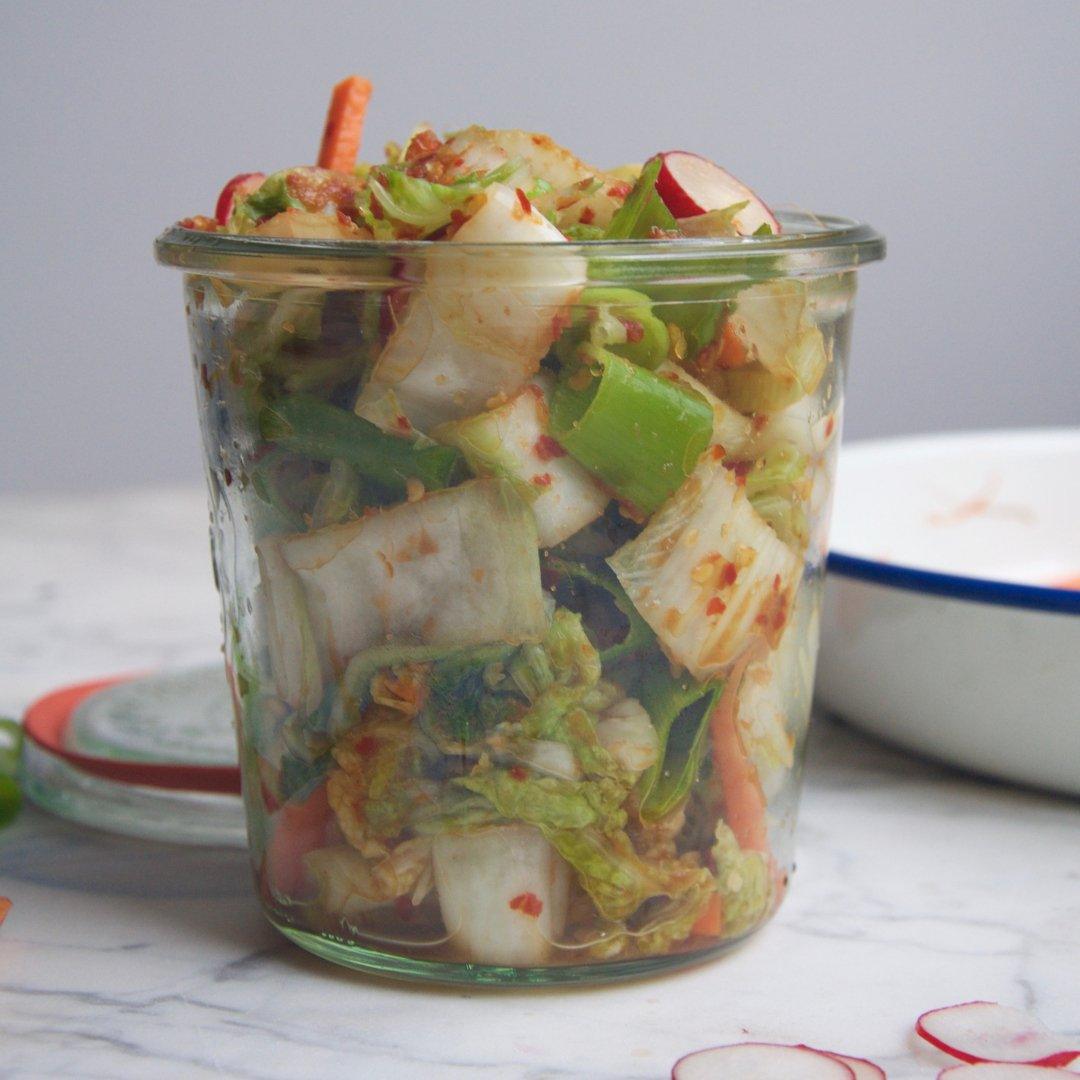Recipe and imagery by: SABI Co-Founder and Holistic Nutritionist, Hilary Metcalfe
I fell in love with kimchi at first bite. Salty, spicy, gingery and garlicky, its complex medley rounds off on a lively sour note. Kimchi is a Korean firework of flavour. It’s also exceptionally good for you and supports gut health.
GUT HEALTH & HORMONE HEALTH
Functional medicine doctors and gut experts often say, if you have a hormonal issue, you most likely have a gut health issue. The two are deeply intertwined. Digestive issues may be how gut health problems often manifest but your cycle health, menopause symptoms and fertility levels may also be indicators.
Did you know women suffer from digestive issues almost 8x more often than men? Issues like gas, pain, bloating, leaky gut and constipation can be caused by a poor microbiome. There is still a lot to be understood about the topic, but researchers agree that plant matter and naturally fermented, probiotic foods like kimchi, sauerkraut and kombucha can help re-populate beneficial gut bacteria. So, feed the colony with this delicious and quick vegetarian kimchi recipe!
KIMCHI FERMENTATION
There are over 200 documented types of kimchi alone, so this crowning symbol of Korean culture and national pride is as much a living thing as the product itself.
Good things come to those who wait: real kimchi is a thing of delicious patience. It takes several days, can ferment for weeks, and lasts for months. Traditionally, it sits in a brine for 6-8 hours, but this recipe cuts prep in half—so, not a true kimchi but still with the benefits of fermentation. The shortcut allows you to enjoy the flavour right away as a quick pickle or quick-chi, within 48 hours. If you give it a week, you get the benefits of both the full probiotic powerhouse and uniquely funky flavour.
RECIPE
Makes: 15 portions
Time: 30 mins active, total 3 hours, including salting and draining the cabbage
INGREDIENTS
1 large Chinese cabbage (about 1kg)
1 carrot, cut into matchsticks
3 spring onions (green and white), roughly chopped
Optional: extra veg, 6 red radishes or ¼ long daikon radish, thinly sliced
4-5 big pinches sea salt

Flavour Paste
4.5cm/2in piece ginger, peeled and grated (yields about 3 Tbsp)
20-30g red chili flakes or gochugaru red pepper powder**
80ml nama shoyu, coconut aminos or soy sauce
60ml coconut sugar, palm sugar or maple syrup
80ml raw apple cider, coconut or rice vinegar
6 cloves garlic, peeled and grated
Half a small yellow or white onion
1 fat pinch sea salt
Equipment
1 large glass jar (about 750ml) or 2-3 smaller jars
1 large glass or wooden bowl, stainless steel
1 large strainer
HOW TO
Be sure your cabbage is clean and dry, but don’t use any antibacterial soap as this will kill the good guys. Prepare the cabbage by slicing off the base and chopping the rest into 2cm pieces, or the width of your index and middle finger. Toss the cabbage into a bowl and add the salt, mixing it in with your hands. This is to extract the water from the cabbage so you have a firmer end product and less water in your kimchi jar, which dilutes the flavours.
Set the cabbage aside for at least an hour, but ideally up to 2.5 hours, in a large strainer over a bowl.. When ready, rinse the cabbage and drain it, squeezing with clean hands to extract more water. Set over a strainer while you make the flavour paste.
Flavour Paste
Combine ingredients in a food processor or blender until it is a well mixed paste. Don’t worry about the little bit of sugar in the recipe; it balances the flavours and is food for bacteria. You can also use some grated apple or pear if you prefer, about half of one medium-sized fruit. If you let your kimchi ferment for a week, the bacteria consume the sugar, resulting in very little net sugar. Set aside the chili paste and chop the other pickling vegetables.
FINISH
Give the cabbage salting in the bowl a quick rinse and squeeze out as much excess water as possible. This is a crucial step that makes more flavorurful and compact kimchi. Layer the pickling veg and flavour paste in with the cabbage in a bowl. Mix with your hands, preferably with a glove so you don’t get chili deep under your nails, where it can later transfer somewhere you definitely don’t want it, like your eye, until all the cabbage is covered with the paste.
You can now enjoy the kimchi as is, or pack it tightly into your very clean glass jar and close the lid, leaving it at room temperature for at least 1 day but up to 7 days in colder weather, about 3 days in warmer weather. Ensure some liquid always covers the top layer by pressing it down with a plate or glass.
Funky Goodness
For quick-chi, you can move it to the fridge after at least 24-48 hours and then consume it within a week. Bubbles may form, it may release more liquid and perhaps a funky smell. This is okay—so is even a little mould, which you can scrape off the top or you can discard the first layer if you feel squeamish about it. But if you see black, pink, or orange mould, then something went wrong and you should toss it.
Fermenting is gardening and cooking in one: sometimes forgiving and sometimes requiring forgiveness, either way, it’s an experiment and usually a delicious process.
Bon appétit!
About Hilary
Hilary is the Co-Founder of the SABI, a Holistic Nutritionist, natural, whole foods Chef, product developer and advocate for women getting to know their bodies, cycles and selves better. Born in Los Angeles, California and raised in Baja California, Mexico, she now lives in Amsterdam, The Netherlands with her partner and her dog, Flint.
















